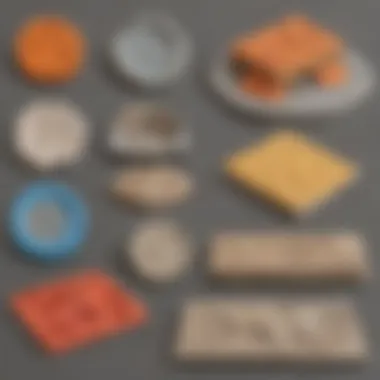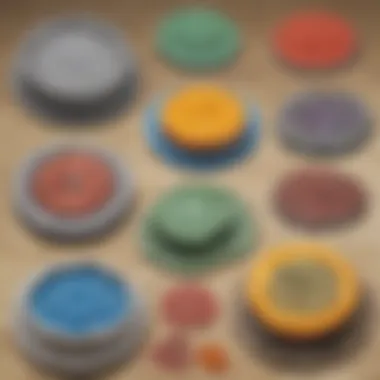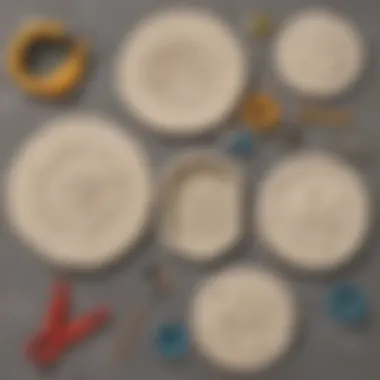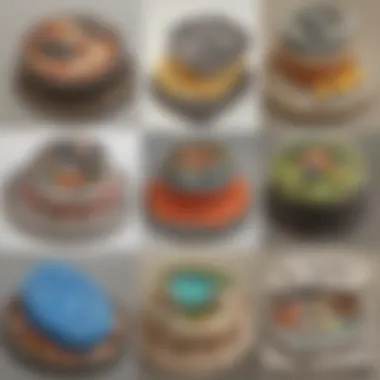Exploring the Versatility of Stepping Stone Mold Kits


Intro
Stepping stone mold kits offer not just a means of creating decorative features in gardens but also serve as an avenue for experiential learning. The appeal of these kits lies in their ability to merge creativity with functionality. Understanding their versatility opens up a world where parents, teachers, and caregivers can engage children effectively. This article is a deep dive into the creative possibilities surrounding stepping stone mold kits, examining their practical applications and celebrating hands-on learning.
Fun Activities Ideas
Using stepping stone mold kits can inspire a variety of fun activities that children and adults can enjoy together. Here are some suggestions to explore:
Indoor Activities
- Craft storage solutions using molds made in unique shapes, great for organizing art supplies.
- Make personalized decorative stones to brighten up an indoor garden or window area.
- Try painting the completed stones before drying to add another layer of creativity.
Outdoor Adventures
- Invite children to help design stepping stones for your yard while discussing the plants that will surround them.
- Organize a community project, where everyone contributes a stone with a unique design for a local park walkway.
Arts and Crafts
Creating with stepping stones doesn’t have to stop at the garden path. Decorating the stones with beads, mosaic pieces, or natural elements like leaves diversifies the craft experience. Run an art session focusing on texture and color applications.
Science Experiments
Leverage stepping stone creation to introduce science, particularly geology. Discuss different types of rocks and their formation process. Engage children in comparing their raw materials used for the stone mixtures.
Cooking and Baking
Although slightly off-topic, stepping stone molds can be converted to create decorative cakes or gelatin treats that resemble stepping stones in a fun twist on cuisine. Use the molds to make edible versions of garden aesthetics!
Parental and Teacher Engagement
Stepping stone projects serve not just as artistic endeavors but also as teaching opportunities about various subjects ranging from creativity to environmental science. As adults guide children, they set a tone for learning through play and collaboration. Fostering such environments draws children towards exploration, discovery, and interaction with their surroundings.
Engaging children in hands-on projects like those involving stepping stones nurtures creativity and resourcefulness from an early age.
Prologue to Stepping Stone Mold Kits
Creating pathways in gardens need not be solely an aesthetic pursuit; it also offers practical functions. Stepping stone mold kits play a crucial role in this endeavor, allowing versatility and uniqueness in every project. They enable users to mold concrete into various shapes that augment any outdoor arrangement, making them valuable for anyone focused on landscape enhancement.
Definition and Purpose
Stepping stone mold kits are sets of tools designed to allow individuals to create customized stepping stones. These kits typically include molds made from different materials such as plastic, silicone, or metal. Not only do they provide a means to create durable stone patterns, but they also simplify the process, even for beginners. The main purpose of such mold kits is to allow for creativity while providing a functional means of navigating garden spaces. The act of creating these stones can also promote outdoor activities and learning.
Popular Uses in Garden Projects
Stepping stone mold kits are not only practical tools; they serve various purposes in gardening. Here are some common applications:
- Pathways: They can be arranged to create natural-looking pathways that encourage visitors to enjoy the surroundings.
- Borders: Molds can shape stones that function as borders to define specific garden areas, giving structure and organization.
- Decorations: Decorations enhance the appeal of gardens, offering a personal touch and showcasing individual style.
- Seat Bases: Larger, flatter stones can serve as bases for outdoor seating, bringing a rustic feel to the space.
- Educational Projects: Engaging kids in DIY stone-making projects promotes handiwork skills and creativity, making them fun teaching opportunities.
These uses highlight not just the functionality of stepping stones in gardens but also their ability to enrich the creative experience while connecting families through active participation.
Types of Stepping Stone Mold Kits
Understanding the various types of stepping stone mold kits is crucial for anyone interested in pursuing creative garden projects. Each type of mold offers unique characteristics that cater to specific preferences and creative aspirations. Therefore, it is essential to evaluate the materials and functions of these kits thoroughly. Choosing the Correct mold can enhance the entire crafting process and lead to stunning results in the garden.
Plastic Molds
Plastic molds are among the most common tools for creating stepping stones. Their advantages include light weight and ease of use. They come in various shapes and sizes, making them adaptable for different design ideas.


For beginners, plastic molds are particularly user-friendly. The surface of the mold allows for smooth concrete pouring, ensuring cleaner edges and less mess. They often come at a lower price point, making them accessible for families or educators who want to engage children in the creative process.
However, plastic molds can become brittle over time, especially if not stored properly. This risk may lead to damage after numerous uses, so it is wise to handle them with care.
Silicone Molds
Silicone molds are becoming increasingly popular for their flexibility and durability. This material allows for easy removal of the finished stones, reducing the risk of breakage during the demolding process. The flexibility of silicone also permits intricate designs that might not be feasible with more rigid materials.
One particularly beneficial feature is the non-stick nature of silicone molds, which makes cleaning and maintenance straightforward. These molds can be reused many times without showing significant wear. Some silicone molds may also allow for the addition of additional decorative elements while casting, enhancing creativity in design.
Despite the advantages, silicone can be relatively pricier than plastic. Therefore, it's essential to factor in the frequency of use and the expected lifespan of the mold when considering this option.
Metal Molds
Metal molds offer a robust option for crafting stepping stones. Typically made from steel or aluminum, they provide stability needed for larger projects. The durability means these molds can withstand heat and may last for a lifetime with proper care.
Metal molds usually require a release agent for easier removal after the concrete cures. This aspect entails additional preparation but provides strong results for intricate stone designs. They can produce sharp edges and clear finishing details, often making them the perfect choice for professional-grade creations.
On the downside, metal molds can be heavy and less portable. They also tend to retain heat, which can affect the curing time of the concrete during warmer months. As a result, taking the local climate into account is wise when selecting metal molds for a specific project.
Choosing the appropriate mold is key to a successful stepping stone project. Considering factors such as material, design, and practicality will contribute to a smoother crafting experience and satisfactory results in the garden.
Materials Needed for Stepping Stone Projects
Understanding the materials required for crafting stepping stones is critical for both beginners and seasoned decorators alike. With the right resources, individuals can create durable and visually appealing stones for their gardens. The choice of materials impacts the design quality, longevity, and overall aesthetic. Having a thorough understanding of these components can enhance the entire experience and create impressive results.
Concrete and Binding Agents
Concrete serves as the foundation for any stepping stone project. Typically, a strong concrete mix comprises Portland cement, sand, and gravel, which results in a robust and lasting stone. The calculation of the mix's ratio is vital to achieve the ideal consistency and strength.
Binder compounds can greatly improve the adherence of the concrete. Common choices include bonding agents such as acrylic additives, which help to prevent cracking and ensure a cohesive mixture. Without proper binding crush, stones may not hold their shape well. Thus, knowing how binding agents enhance the overall durability of stones is beneficial for long-term projects.
Coloring Agents and Earth Elements
Coloring agents play a key role in introducing hues and tones to stepping stones. The simplest option is using concrete dyes or pigments. For notable impacts, elements such as flower petals, colored glass shards, and seashells can be mixed in. These not only provide color but can also introduce unique textures that differentiate each stone. This incorporation of natural materials reflects creativity and personal touches in the crafting process.
Incorporating earthen elements has two benefits: aesthetic enhancement and adhesion improvement. Some artisans include sand, gravel, or small pebbles for added texture and visual stimulation in their designs. By utilizing both coloring agents and local earth elements, makers can construct more personalized and striking stones.
Tools and Equipment
The correct tools and equipment are essential for any creative endeavor. Basic tools include mixing buckets, trowels, and smoothers for handling concrete. A sturdy level ensures each stone stays level on the ground. Molds are undoubtedly a primary equipment piece; those will determine the stone's shape and design. Adjustable molds allow for versatility in design, which can inspire different ideas.
Other accessories include protective gloves, safety goggles, and sealing equipment. Sealing is often overlooked but should not be dismissed. A good sealant protects the stone from weathering, thereby extending the life of DIY efforts.
Key Materials Summary:
- Concrete is the crucial base
- Binding agents ensure durability
- Coloring agents enhance aesthetic appeal
- Tools provide ease in construction
Selecting quality materials can foster creativity and make stepping stone projects more enjoyable for kids and guardians.
Step-by-Step Guide to Making Stepping Stones
Creating stepping stones can be a fulfilling project that combines creativity and practicality. This section serves as a comprehensive guide that highlights the process of making stepping stones. Adopting a systematic approach ensures successful outcomes and helps readers make the most of their stepping stone mold kits. Each step contains specific elements, assigning significance not just to the end product but also to the experience shared by children, parents, and educators involved in this activity.
Preparing the Mold
Preparing the mold is the first and perhaps one of the most significant steps in making stepping stones. Start by ensuring the chosen mold is clean and dry. A thorough wash with warm, soapy water works well. Once dry, it is crucial to use a release agent. This can be a light spray of cooking oil or a specialized mold release product. Applying it helps the mixed concrete detach seamlessly from the mold after it is set. This step greatly reduces frustration and enhances the quality of the might-be perfected stone.
Mixing and Pouring Concrete


Careful measurement of the materials is important when mixing concrete. General purpose concrete mix readily serves this purpose. Follow the instructions on the package, typically mixing it with water to achieve a thick yet pourable consistency. While combining the mixture, do not overmix. This may add air bubbles, which can weaken the stone integrity. Pour the mixture into the mold steadily, ensuring no air pockets form. A gentle tap on the mold can help settle and distribute the mix evenly. Level the surface for a smooth finish, making it easier to enhance later.
Enhancing with Decorative Elements
One of the striking aspects of creating stepping stones involves adding personal touches. Decorative elements can be anything from pressed flowers, smooth pebbles, or colorful glass pieces. Plan the design before mixing the concrete for better clarity. After pouring, place these elements into the wet concrete visually appealing. A great tip is to use layers—initially pour a thin layer of concrete, add decorations, then pour more concrete to set them securely. This ensures they are incorporated well without showing on the surface later.
Curing and Finishing Techniques
Proper curing of the concrete stepping stones is essential for durability. After the concrete is poured and enhanced, cover the mold with plastic to retain moisture. Let them cure for at least 24 to 48 hours, depending on the weather conditions. Curing on an overcast day enhances the strengthening process. After the curing period, remove the stones gently from the molds. Inspect for any rough edges; these can be smoothed down using sandpaper. Finally, where applicable, apply a sealant for weatherproofing to extend the lifespan of your creations.
Creativity Through Customization
Customization in stepping stone projects holds significant value. It transforms standard gardening activities into personal expressions. Tailoring designs allows both children and adults to engage creatively. Each stone becomes a unique item, reflecting individual backgrounds, interests, and flair. Participating in such interactive projects strengthens bonds among family members. This process adds emotional richness to something as basic as stepping stones.
Incorporating Kids' Artwork
Kids' artwork can breathe life into stepping stones. Their expressions can vary from finger painting to abstract designs. Working with kids encourages them to think creatively and develop artistic skills. It can also foster a personal sense of ownership of their creations. Besides, these projects boost their self-esteem when children see their designs featured prominently in the garden.
To incorporate artwork into stepping stones, parents might consider the following:
- Collect various art pieces favorite drawings or paintings.
- Transfer the artwork onto the stone surface by using special transfer sheets or outright painting it on.
- Use bright colors and playful shapes to resonate with children's vibrant imaginations.
Utilizing kids' artwork emphasizes their creativity and validates their artistic interests in a productive way.
Thematic Designs and Patterns
Creating thematic designs can align the stepping stones with specific interests. This method allows for a planned, cohesive feel throughout the garden or yard. Consider themes like nature, seasons, or favorite family memories. These thematic designs can serve both decorative and educational purposes.
Finding inspiration can come from numerous sources:
- Nature - leaf patterns, flower shapes, or animal footprints.
- Holidays - themed stones for Halloween, Christmas, or any specific celebration.
- Family history – incorporating dates, names, or locations relevant to family stories.
Designs can also be formal or informal depending on personal preference. Custom patterns may also mix certain styles, combining modern trends with classic motifs. In the fray of theme-building, individuals must remain flexible. New ideas often crystallize through experimentation.
Benefits of Using Stepping Stone Mold Kits
Stepping stone mold kits serve various purposes beyond mere aesthetics in garden design. They promote valuable lessons that resonate with the experience of working creatively and learning important life skills. The use of these kits is beneficial not only for crafting beautiful garden paths but also for educational undertakings that delve into exploring design, teamwork and even Physics.
Fostering Creativity in Children
Stepping stone projects enable children to step into world of creativity while producing tangible results. This artistic outlet allows kids to express their thoughts and ideas through design. Each stone can serve as a unique canvas for the individual's style.
- Template Creation: Using the molds, children can outline their designs using different colors or patterns.
- Exciting Materials: There are numerous possibilities for adding flourishes, like stones or glass, that catalyze creative thinking during stone-making sessions.
- Inclusive Experiences: Family involvement can elevate creativity; children may find inspiration from their peers and parents during these activities.
Engagement in artistic projects fosters imagination, nurturing a lifelong appreciation for creative pursuits.
Learning Hands-On Skills
Stepping stone projects introduce an important principle: learning by doing. This method confirms that practical skills are just as valuable as theoretical knowledge. Participants will symbolically transition from passive recipients of information to active manipulators of materials.
- Mixing and Pouring: Children learn exactly how to mix concrete, estimations, and measurement skills. These hands-on practices aid mathematical framework development.
- Transferring Skills: They will grasp product manipulations, from molding to destruction, implying that monitoring results to overcome failure is essential. Through activities, one can evaluate outcomess without being limited by prior models.
- Sharing Knowledge: Kids also learn to convey insights to friends or family once they master the processes.
Building Patience and Focus
Working with bland materials can teach children about persistence. This becomes especially crucial when working with mixtures and waiting periods like curing.
- Delayed Gratification: Observing a stone that takes time to develop and improve prepares individuals for real-world scenarios where results may not be instantaneous.
- Attention-to-Detail: Each phase requires precision; wrongly mixed cement or a loose color detail can disrupt planned results.
- Resilience: If a stone fails or cracks, replicating a previous effort teaches kids that creating is not linear, instilling a sense of fortitude.


Creativity, practical skills, patience, and focus come together. Collectively, these elements enrich the experience of using stepping stone mold kits, ensuring they contribute significantly beyond the garden path.
Safety Considerations During the Activity
When embarking on any creative project, particularly those involving children, safety considerations need to take precedence. Stepping stone projects, while rewarding and fun, require a structured approach to ensure that all participants engage in a safe manner. Taking measures such as understanding tool usage and handling materials safely can make a significant difference. Thus, a responsible adult should always supervise the activity to foster a secure environment.
Tools and Equipment Safety
When using tools for stepping stone projects, instructive handling should not be overlooked. Appropriate precautions must be in place to minimize risks of injury. Common tools may include mixing containers, shovels, spatulas, and various implements for decoration.) Each of these tools can present hazards if misused or improperly handled.
- Always read and understand the user manual if available.
- Wear protective gloves to shield from scratches or cuts when handling sharp instruments.
- Use safety goggles to prevent debris from getting into the eyes during mixing or pouring activities.
- Ensure that workstations are kept clean and well organized, reducing the risk of tripping or mishaps with tools lying around.
Always prioritize safety first to enjoy the creative process.
Fostering a safety-focused workspace is crucial. By leading by example, adults can teach children safe habits, laying foundations for responsible, mindful crafting practices in the future.
Handling Concrete Safely
Concrete is a fundamental component in stepping stone projects. It is not only heavy but can pose danger if handled without care. Understanding concrete's nature is important. It is highly alkaline, and prolonged exposure can irritate the skin. Here are some safety considerations:
- Wear long gloves: Prevent direct contact with the skin to avoid irritation.
- Mask and gloves for dust protection: If mixing dry concrete, using a mask can block the inhalation of harmful dust.
- Footwear: Sturdy, non-slip footwear will help in maintaining balance and stability during the project.
- Mix in small batches: This prevents excessive exposure and makes handling easier, especially for kids.
Curing is another vital phase. Allow proper ventilation when concrete is curing to minimize one’s inhalation of any fumes that might be released.
Taking these precautions can help create a more enjoyable and meticulous crafting experience. The overall aim is to engage creatively without compromising well-being.
Maintaining and Caring for Stepping Stones
Stepping stones can enhance both the aesthetic and functional aspects of your garden or yard. To optimize their lifespan and maintain their beauty, proper care is critical. Keeping stepping stones in good condition includes more than just the initial decorative touch; it involves ongoing attention to their wellbeing. Cleaning, sealing, and handling repairs when damages occur are all part of the maintenance process. By understanding these pivotal aspects, families can ensure the longevity of their stepping stones and continue to benefit from these creative projects.
Sealing and Weatherproofing
Sealing stepping stones is essential to protect them from various environmental factors. Weather can cause materials to deteriorate over time. Moisture from rain and snow can seep into the stones, leading to cracks and erosion.
To effectively weatherproof, you can follow these simple steps:
- Choose a high-quality concrete sealant designed specifically for outdoor use.
- Apply the sealant using a brush or roller, ensuring full coverage on the stone surfaces.
- Make sure to use sealants that are UV resistant to prevent fading.
- Allow adequate drying time as per the product's instructions before exposing them to the elements.
By doing this, you will be able to protect your stepping stones from the rain, sunlight, and extreme temperature fluctuations. This proactive measure prolongs their freshness and preserves their appearance for many seasons.
"Regular maintenance can add years to the life of your stones and enhance the overall aesthetic of your outdoor spaces."
Repairing Damaged Stones
Damage to stepping stones can occur, whether due to weather conditions, foot traffic, or accidental impacts. Knowing how to repair these stones is vital to maintaining a beautiful walking path. Don't despair at a small crack or chip; many solutions are available.
- Use epoxy or a concrete repair compound for small cracks. Fill the crack and smooth over with a spatula or a similar tool.
- For larger breaks, consider reassembling pieces but ensure the surface is clean and dry before attempting repairs.
- Sand the edges lightly after drying to ensure a smooth finish that blends in with the original stone.
- If your stepping stone is severely damaged, consider creating a new one using the mold kits.
Regular inspection can help catch these damages early, making repair simpler. Most importantly, repairing stepping stones enhances their look and value, ensuring they remain functional elements in your garden landscape.
Understanding how to maintain and care for stepping stones ensures that they serve as beautiful and sturdy walkways for years to come.
Epilogue
In approaching the conclusion of this article, the relevance of stepping stone mold kits emerges clearly. These kits not only serve functional purposes within garden design but also extend their utility into educational and developmental dimensions for children. Engaging with mold kits encourages creativity, instills patience, and promotes problem-solving skills, making it an ideal choice for parents, teachers, and guardians.
Stepping stone projects represent a convergence of fun and learning, transforming simple activities into enduring lessons.
The thematic versatility of these kits carries significant weight. Family bonding grows deeper as children express their imaginations through these hands-on activities. Learning traditional craftsmanship offers substantial rewards, helping children to understand the importance of manual skills.
Considering safety, providing the right guidance ensures enjoyable experiences. Adults play a critical role in mitigating hazards, from tool usage to handling concrete, ultimately creating a conducive environment for exploration and creativity.
Furthermore, maintenance becomes important. Understanding how to properly care for the finished stones ensures they remain as beautiful and functional elements in the outdoor environment. Whether sealing, repairing, or weatherproofing, these practices contribute to longer-lasting projects.



